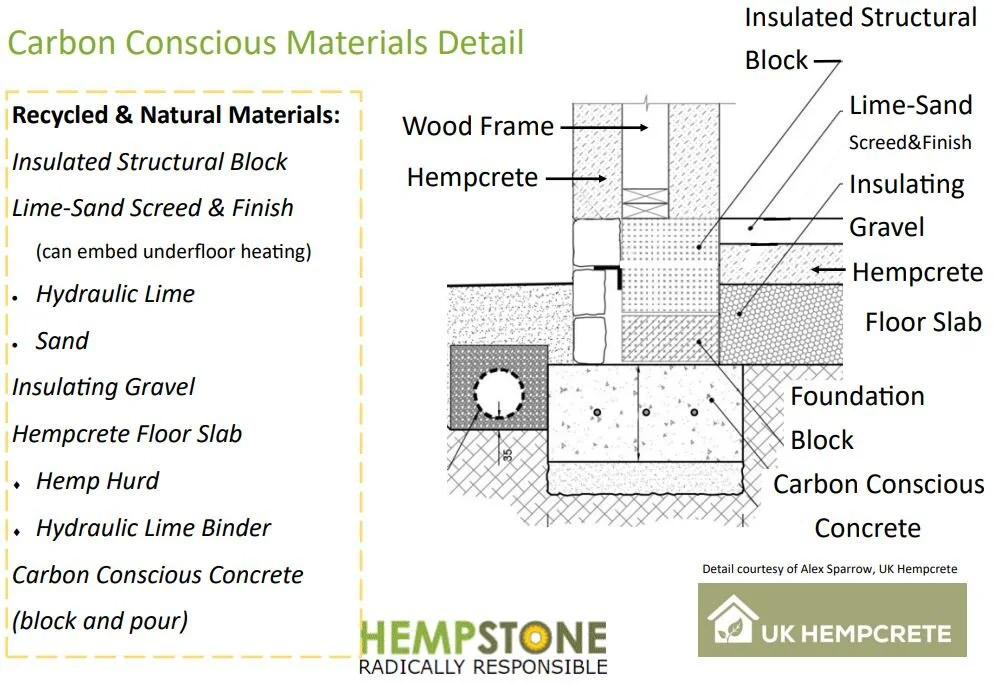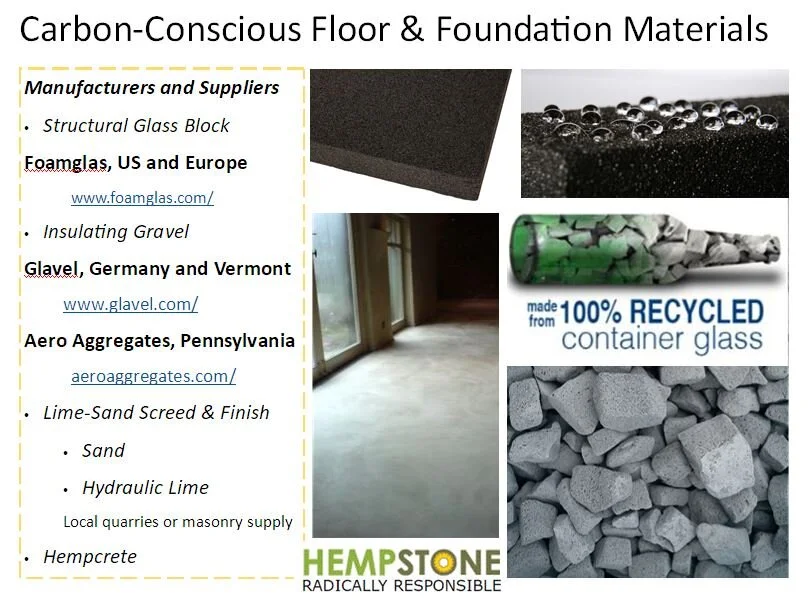Carbon-Conscious Foundations
Just how ECO can foundations get?
When carbon-savvy professionals first learn about hempcrete, the inevitable question becomes, “Can I build a foundation wall, or insulate a sub-grade insulation wall, with hempcrete?” I hate shattering their carbon-beneficial foundation dreams, but feel obligated to state irrefutably that bio-based materials like hemp are best used above grade.
While below-grade use is possible, there are a few caveats:
As hempcrete is not structural, a separate, structural element must be incorporated.
Hempcrete must not come into contact with hydrostatic water (water in the ground outside your foundation walls) or standing water (as sometimes occurs in a basement). This means that all bulk water (water coming off the roof and in the ground) must not come into contact with hempcrete.
Hempcrete in below-grade applications should be considered experimental. Robust design and construction detailing and on-going performance monitoring are essential components to any experimental building process.*
*Note: If you can’t help yourself, and are interested in experimental hempcrete applications below grade, give HempStone a call to go over details.
For the average designer, builder, or home-owner, a hempcrete foundation simply isn’t in the cards. So, what ARE the options for a carbon-conscious foundation?
Carbon Conscious Solutions for Foundations
Typical Carbon-Conscious Detail by UK Hempcrete
HempStone and UK Hempcrete illustrate how to bring carbon-conscious materials to foundation assemblies.
The primary materials in this assembly are:
expanded glass (in gravel and block form),
lime-sand,
hempcrete (above grade),
concrete with carbon-conscious amendments (with added inert pozzolanic additives or carbon-dioxide aeration).
Carbon Conscious Concrete
Concrete has been around for millennia, and humans have continued to tweak the fundamental recipe to address changing requirements and conditions. Portland cement, an often lauded formulation that is now scrutinized for its high embodied carbon content, was invented in 1824. In the years following World War II, portland cement became the conventional norm, and concrete use has grew quickly in the second half of the century. In the 21st century, US production of portland cement has leveled off, now hovering around 100,000,000 tons.
For years, industrial waste additives of fly ash (from coal firing), blast furnace slag (from steel manufacturing) and silica fume (from silicon production) have typically been added to lower the percentage of portland cement. These materials have their own embodied carbon footprints, and rely on dwindling industries in the United States. Nowadays, recycled post-consumer glass and high-reaction metakaolin are becoming more accessible carbon-conscious solutions as additives.
how to Access New concrete Formulations
Step One:
When using concrete, find ways to reduce the embodied carbon of the formulation. This work has been ongoing for decades, and by now, your local concrete manufacturer should be able to speak intelligently about this. Instead of only specifying strength, start your conversation by asking for a low-emission concrete. Ask what they add to their formulations to lower the portland cement, and inquire about the source location.
Step Two:
If you have more than one concrete plant in your area, ask each plant for their formulations, as well as their plant-based decarbonization plans, and purchase accordingly. Savvy concrete plants who have their fingers on the pulse of the embodied carbon in their formulations are worth their weight in gold, and deserve both our dollars and acclaim.
Step Three:
Looking to push the envelope? Check out companies that are going beyond additives and formulations to inject carbon dioxide into concrete. CarbonCure Technologies and Blue Planet are two companies who offer this service. These companies partner with ready-mix concrete companies across the continent, so inquire about the possibilities in your area.
Plan, Design, Act
Carbon-conscious foundations are both possible and practical. It simply takes a bit of effort to expand the specification list to incorporate new materials, engage existing suppliers, and develop proficiency with new construction processes. While it takes a bit of effort, it’s a definitively powerful way to manifest the needed changes in our built environment today.


